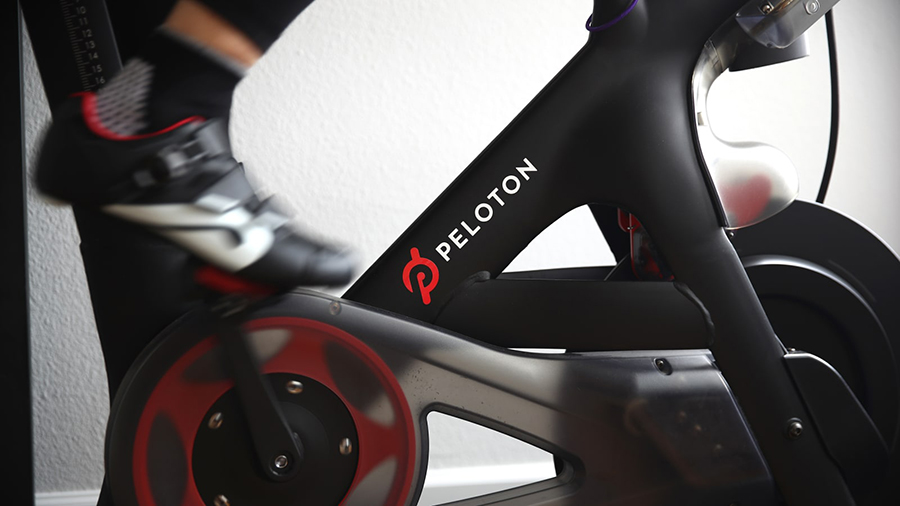Shares of Peloton Interactive fell $9.75, or 8.5 percent, on Friday to $104.34 after the connected fitness leader announced plans for a price cut on its original Bike product and a lower-than-expected outlook for its current first quarter and FY22 following a massive treadmill recall. Many analysts nonetheless remain bullish on Peloton’s growth prospects, including the potential for a strong Tread launch.
Since starting the year, Peloton’s shares have been under pressure at $151.72, primarily tied to the recall that impacted around 125,000 Tread+ systems and more than 5,500 Treads. Shares soared in 2020 as the home-fitness trend took off during the pandemic. Peloton closed 2019 at $27.31.
Highlights of the fiscal fourth quarter ended June 30 and outlook include:
- Total revenue grew 54 percent to $936.9 million from $607.1 million a year earlier, topping estimates for $927.2 million;
- Adjusted EBITDA was a loss of $45 million against a positive EBITDA of $143.6 million a year ago. Results topped Wall Street’s consensus calling for a negative EBITDA of $126 million;
- The net loss came to $313.2 million, or $1.05 per share, compared with a net income of $89.1 million, or 27 cents a share, a year earlier. Results came in below Wall Street’s consensus estimate, calling for a loss of 45 cents;
- Connected Fitness subscribers closed the quarter at 2.33 million, up 114 percent from 1.09 million a year ago and just ahead of consensus targets of 2.29 million;
- Revenue from Peloton’s Connected Fitness segment, which includes contributions from the company’s acquisition of Precor, rose 35 percent year-over-year to $655.3 million, representing 70 percent of total revenue. Subscription revenue was up 132 percent to $281.6 million;
- Average net monthly connected fitness churn, which Peloton uses to measure retention of connected fitness subscribers, ticked up to 0.73 percent from 0.52 percent a year earlier;
- Average monthly workouts per connected fitness subscriber fell to 19.9 from 24.7 a year earlier that Peloton attributed to seasonal trends, such as more people vacationing during the summer months or spending more time outdoors;
- Sales are expected to reach $800 million for the first quarter, down from Wall Street’s consensus target of $1.02 billion. The lower guidance reflects the announced price reduction of its Bike by $400 to $1,495 and a “modest” revenue contribution from the Tread;
- Peloton anticipates having 2.47 million Connected Fitness subscriptions by the end of the first quarter, below analysts’ consensus target of 2.51 million;
- Adjusted EBITDA is expected to be negative $285 million against consensus, calling for a positive EBITDA of $16 million. Last-mile delivery costs are expected to reduce margins in its historically slower three-month period;
- For the fiscal 2022 year, sales are expected to hit $5.4 billion, up from the analysts’ consensus target of $5.3 billion; adjusted EBITDA was seen as negative $325 million against consensus, calling for positive EBITDA of $233 million; and Connected Fitness subscribers are seen expanding to 3.63 million versus the consensus target of 3.48 million; and
- Peloton expects to return to profitability by fiscal 2023.
The following is a synopsis of analyst views on the quarter and outlook.
»Loop Capital Markets lowered its price target to $135 from $140 but kept its “buy” rating on Peloton’s shares as it sees the sell-off as a buying opportunity for long-term investors.
 “With the benefit of hindsight, it would have been unwise to sell AAPL shares when the company lowered the price of its first-generation iPod,” wrote Senior Analyst Daniel Adam, Loop Capital Markets. “For the same reason, we think it is unwise to impulsively sell PTON after lowering the price of the Bike. Declining hardware prices are, for better or worse, a reality for tech companies like PTON. However, it is imperative, in our view, not to overlook the fact that more accessible price points also expand the addressable market.”
“With the benefit of hindsight, it would have been unwise to sell AAPL shares when the company lowered the price of its first-generation iPod,” wrote Senior Analyst Daniel Adam, Loop Capital Markets. “For the same reason, we think it is unwise to impulsively sell PTON after lowering the price of the Bike. Declining hardware prices are, for better or worse, a reality for tech companies like PTON. However, it is imperative, in our view, not to overlook the fact that more accessible price points also expand the addressable market.”
Adam noted that Peloton delivered better-than-expected guidance in the quarter on revenue, EBITDA and Connected Fitness subscribers. While Q122 and FY22 guidance were significantly below Wall Street’s targets, he believes the guidance appears excessively conservative while noting that Peloton has regularly exceeded guidance since going public two years ago. Adam wrote, “We believe the impact of the Tread+ recalls and price cut on the Bike will be more muted than what the company has currently baked into its guidance.”
»Credit Suisse eased its price target on Peloton to $148 from $151 while retaining its “Outperform” rating.
 Kaumil Gajrawala, managing director and equity research analyst, Credit Suisse, wrote in a note, “Peloton is playing the long game by dropping the price on Bike, sacrificing profitability for customer lifetime value.
Kaumil Gajrawala, managing director and equity research analyst, Credit Suisse, wrote in a note, “Peloton is playing the long game by dropping the price on Bike, sacrificing profitability for customer lifetime value.
Importantly, we think it broadens the appeal and significantly expands their addressable market, keeping organic demand high.”
He noted that Peloton’s management remains bullish on the Tread opportunity, still seeing treadmills as potentially two to three times larger than the bike category. Officials also expect about half of fiscal 2022 Tread sales to go to existing subscribers.
Recent initiatives-corporate wellness, UnitedHealth partnership-the less-expensive Bike, international growth and a rumored release of a rower, all could support full-year growth targets. Finally, Gajrawala said Peloton remains committed to aggressively advertising into peak selling season and continuing to develop offerings to meet the challenge of new competition in the home fitness space.
Gajrawala attributed the shortfall in Q1 guidance in part to the return of the typical slowdown in sales during the summer following last year’s pandemic-driven surge and said delivering on second-quarter and third-quarter revenue targets will be critical. The analyst stated, “With the focus now on F22, where tough comps, reopening dynamics, and the Tread will all play a role, we think past investments put the company in a position to deliver.”
»Merrill Lynch upgraded shares of Peloton to “Buy” and lifted its price target to $138 from $135.
 The investment firm had turned more cautious on Peloton given reopening uncertainty and early sales data on Tread. However, analyst Justin Post, managing director, internet analyst, thinks “most of the reopening surprises are behind” Peloton, and the stock’s sell-off offers “a better entry point for those, like us, that believe the Tread launch will be the next big driver of growth for Peloton.”
The investment firm had turned more cautious on Peloton given reopening uncertainty and early sales data on Tread. However, analyst Justin Post, managing director, internet analyst, thinks “most of the reopening surprises are behind” Peloton, and the stock’s sell-off offers “a better entry point for those, like us, that believe the Tread launch will be the next big driver of growth for Peloton.”
Key points in the upgrade include Pelton management’s comments about “incredibly strong leads” for its treadmill and Peloton’s continued bullishness on the Tread opportunity. Post wrote, “Longer-term, management continues to suggest that Tread sales can outpace Bike, and we continue to think the global in-home fitness industry can reach over 50mn subs.”
Post also suspects Bike sales will regain momentum in the current quarter with normal seasonality and highlighted the strength of Peloton’s “best in class” churn rate (average monthly connected fitness churn at 0.73 percent in the fourth quarter).
Finally, Post said Peloton has more potential catalysts than the vast majority of stocks he covers, including strength products, rowing products, new corporate and insurance deals, international launches, acquisitions, and the return of Tread+.
The analyst cautioned that management’s outlook for strong Tread sales and normal seasonality could be disrupted by reopening and other factors. He added, “Near-term, we expect strong debate on if the $400 bike price cut was driven by lower-than-expected F1Q demand, but we think this debate will be quickly superseded by a focus on Tread sales data in September.”
»Baird maintained its “Outperform” rating and its $160 price target.
 Jonathan Komp, CFA, Baird, noted that while the updated guidance may fuel near-term bear arguments, “we see many positive longer-term strategic implications from actions to prioritize market share.”
Jonathan Komp, CFA, Baird, noted that while the updated guidance may fuel near-term bear arguments, “we see many positive longer-term strategic implications from actions to prioritize market share.”
He said while the fourth quarter upside reflected the anticipated work down of Bike and Bike+ backlog, Peloton officials noted that they expected to sell more units in the current fiscal year than the just-completed year. The optimism comes amid concerns that significant bike sales had been pulled forward during the pandemic. He also sees that the move to reduce the price of the Original Bike by $400 and its monthly financing rate by $10 to $39 is designed “to take advantage of increased production capacity/efficiencies to drive high-LTV (long-term value) subscriptions.”
Also encouraging was Peloton management’s enthusiasm around the Tread launch on August 30. Officials cited an 85 percent NPS (net promoter score) in Canada and the U.K., where the device was first launched, and strong online leads and a high likelihood that Bike/Bike+ owners will purchase the Tread.
Komp cited positives in Peloton’s unique vertically integrated subscription+box model, strong consumer affinity, the benefit of its recent actions to broaden accessibility and launch new products, and the growth potential of at-home fitness. He wrote, “While we are somewhat disappointed to see profitability take a step backward over F2022-2023E relative to our prior expectations, we still see prospects for favorable unit economics and rapidly expanding margin over time.”
 »Stifel kept its “Buy” rating on shares of Peloton and its price target at $140.
»Stifel kept its “Buy” rating on shares of Peloton and its price target at $140.
Scott Devitt, managing director, internet equity research, Stifel, wrote in a note that while heightened investment, price reductions and supply chain costs would weigh on near-term margins, many of the underlying costs support growth. The lower Connected Fitness gross margin stems from higher commodity costs, elevated freight rates, product mix shift, and the price decrease in the original Bike. Margins would also be impacted in the near term by investments to market the Bike price reduction and its lower-priced Tread, increase Digital-to-Connected Fitness conversions, and further build its software and content pipeline to drive engagement.
Devitt also noted that Peloton expects supply chain investments to support inventory needs to enable the company to meet upcoming peak demand during its fiscal second and third quarters and has significantly improved order-to-delivery times to currently around one to three weeks.
Devitt stated, “While the near-term profitability outlook is pressured, we note that gross margin headwinds are largely transitory and should abate through the year as conditions normalize. Importantly, FY22 guidance calls for revenue and CF (Connected Fitness) subscribers ahead of expectations despite challenging prior-year compares and normalizing consumer behavior. We continue to see multiple drivers for sustainable growth with the upcoming Tread launch, ongoing international expansion and opportunities for new hardware.”
Photos courtesy Peloton, Daniel Adam, Kaumil Gajrawala, Justin Post, Jonathan Komp, Scott Devitt
















